

In the early morning hours of May 2, 2025, Delhi was hit by a sudden and intense rainstorm. An active western disturbance, two cyclonic circulations over Rajasthan, an anti-cyclonic circulation over the Arabian Sea and another over the eastern coast could be the likely reasons behind the intense storm activity over the city.
The rainstorm killed at least four people, inundated many parts of Delhi and the National Capital Region and led to the cancellation of over a hundred flights from the city.
The Safdarjung observatory of the India Meteorological Department (IMD) in southwest Delhi recorded 77 millimetres (mm) of rainfall between 8:30 am on May 1 and 8:30 am on May 2. The Lodhi Road observatory recorded 78 mm of rainfall in the same period.
The actual rainfall occurred in just over three hours between 5:15 am and 8:30 am on May 2, according to the rainfall chart from IMD.
The intense rain was accompanied by swift gusts of winds with speeds of up to 80-90 km/hr which was the primary reason for trees getting uprooted in different parts of the city.
On April 30, the IMD had predicted that an active western disturbance would start affecting northwest India from May 2. In its press release, the weather agency had stated “isolated to scattered rainfall with thunderstorm, lightning & strong winds speed reaching 40-60 kmph likely over Punjab, Haryana Chandigarh & Delhi, Uttar Pradesh, Rajasthan during 30th April to 05th May.”
A western disturbance is an extra tropical storm that originates in the Mediterranean region and travels over Iran, Afghanistan and Pakistan to bring most of India’s winter rainfall and causes storms during the pre-monsoon season. The frequency of these essential weather agents has increased in the summer months, likely due to global warming and consequent climate change.
In its press release on May 1, IMD indicated the presence of a cyclonic circulation over southwest Rajasthan and another one over southeast Rajasthan. A cyclonic circulation is a swirling of winds in a cyclone-like pattern in the middle to upper layers of the atmosphere, which is often responsible for the origin of storms in the lower layers of the atmosphere.
The storm likely formed under the influence of these three major weather systems over the region, with many localised factors such as land surface heating and moisture levels in the lower layers of the atmosphere also playing a part.
The other significant factor which could have played a part is the ongoing neutral El Nino Southern Oscillation (ENSO) conditions in the equatorial Pacific Ocean. According to the IMD, these conditions are closer to La Nina conditions, a reason the weather agency has predicted a possible excess monsoon season in 2025.
In such a situation, the easterly winds over India are strengthened which can lead to more intense thunderstorms with accompanying rainfall.
“The western disturbance got a booster shot from the anticyclone that’s been spinning over the Arabian Sea for weeks,” Raghu Murtugudde, professor of climate studies at the Indian Institute of Technology, Bombay and emeritus professor at University of Maryland told Down To Earth.
An anticyclone is a region of high atmospheric pressure with winds flowing in the downward sinking motion and is mostly responsible for causing heat waves.
“The other twin centre (anticyclone) over parts of the east coast resulted from the cross-equatorial winds into India running up along the coast along the eastern edge of the Arabian Sea circulation,” he added.
IMD and other forecasters have predicted rains over Delhi to continue for the next few days. Murtugudde portends that “it’s going to be interesting to see how the two anti-cyclones will play together with any cyclones or up to the monsoon onset”.